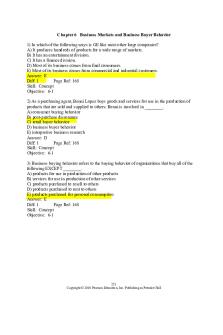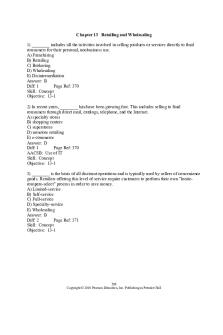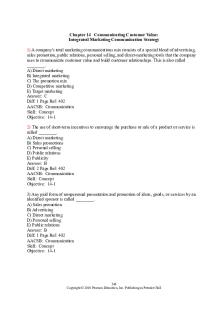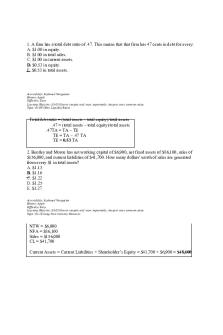Kotler Chapter 2 MCQ - Multiple choice questions with answers PDF
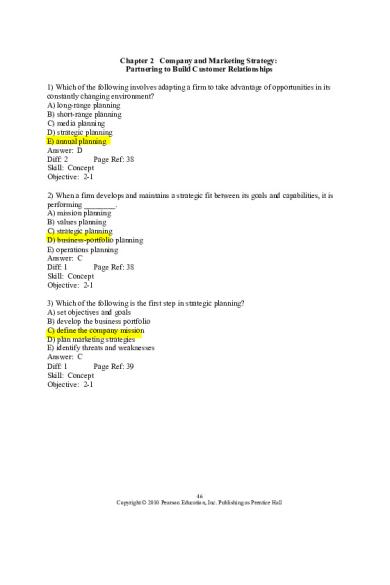
| Title | Kotler Chapter 2 MCQ - Multiple choice questions with answers |
|---|---|
| Course | Principles of Marketing |
| Institution | The University of the West Indies Mona |
| Pages | 42 |
| File Size | 407.9 KB |
| File Type | |
| Total Downloads | 50 |
| Total Views | 435 |
Summary
Chapter 2 Company and Marketing Strategy: Partnering to Build Customer Relationships Which of the following involves adapting a firm to take advantage of opportunities in its constantly changing environment? A) long-range planning B) short-range planning C) media planning D) strategic planning E) an...
Description
Chapter 2 Company and Marketing Strategy: Partnering to Build Customer Relationships 1) Which of the following involves adapting a firm to take advantage of opportunities in its constantly changing environment? A) long-range planning B) short-range planning C) media planning D) strategic planning E) annual planning Answer: D Diff: 2 Page Ref: 38 Skill: Concept Objective: 2-1 2) When a firm develops and maintains a strategic fit between its goals and capabilities, it is performing ________. A) mission planning B) values planning C) strategic planning D) business-portfolio planning E) operations planning Answer: C Diff: 1 Page Ref: 38 Skill: Concept Objective: 2-1 3) Which of the following is the first step in strategic planning? A) set objectives and goals B) develop the business portfolio C) define the company mission D) plan marketing strategies E) identify threats and weaknesses Answer: C Diff: 1 Page Ref: 39 Skill: Concept Objective: 2-1
46 Copyright © 2010 Pearson Education, Inc. Publishing as Prentice Hall
4) Which of the following is NOT a step in the strategic planning process? A) defining the company mission B) setting company objectives and goals C) designing the business portfolio D) planning marketing and other functional strategies E) evaluating all members of the value chain Answer: E Diff: 2 Page Ref: 39 Skill: Concept Objective: 2-1 5) Which of the following provides an answer to these questions: What is our business? Who are our customers? What do our customers value? What should our business be? A) objectives and goals B) a mission statement C) a business portfolio D) marketing and functional strategies E) operational strategies Answer: B Diff: 2 Page Ref: 39 AACSB: Communication Skill: Concept Objective: 2-1 6) ________ should be market oriented and defined in terms of ________. A) Annual plans; product needs B) Strategic plans; company needs C) Long-range plans; company needs D) Mission statements; customers' needs E) Objectives; competitors' threats Answer: D Diff: 2 Page Ref: 39 AACSB: Communication Skill: Concept Objective: 2-1
47 Copyright © 2010 Pearson Education, Inc. Publishing as Prentice Hall
7) All of the following are accurate guidelines for a company's mission statement EXCEPT which one? A) A mission statement should be realistic. B) A mission statement should be narrow. C) A mission statement should emphasize the company's strengths in the marketplace. D) A mission statement should be specific. E) A mission statement should motivate employees. Answer: B Diff: 3 Page Ref: 39 AACSB: Communication Skill: Concept Objective: 2-1 8) A company's mission statement serves as a statement of ________. A) fact B) values C) purpose D) financial goals E) employee commitment Answer: C Diff: 2 Page Ref: 39 AACSB: Communication Skill: Concept Objective: 2-1 9) Which of the following is NOT a market-oriented business definition? A) "to make the Internet buying experience fast, easy, and enjoyable" B) "to sell tools and home repair and improvement items" C) "to deliver low prices every day" D) "to be the guardian of our customers' financial dreams" E) "to bring aspiration and innovation to every athlete in the world" Answer: B Diff: 2 Page Ref: 40 AACSB: Reflective Thinking Skill: Concept Objective: 2-1
48 Copyright © 2010 Pearson Education, Inc. Publishing as Prentice Hall
10) All of the following are examples of product-oriented mission statements, EXCEPT which one? A) "We provide online services." B) "We run theme parks." C) "We sell shoes." D) "We sell lifestyle and self-expression; success and status; memories, hopes, and dreams." E) "We rent hotel rooms." Answer: D Diff: 2 Page Ref: 40 AACSB: Reflective Thinking Skill: Concept Objective: 2-1 11) Which of the following is the principle objective of a market-oriented mission statement? A) to satisfy basic customer needs B) to satisfy basic supplier needs C) to satisfy basic stockholder needs D) to satisfy basic owner needs E) to satisfy basic partnership needs Answer: A Diff: 2 Page Ref: 39 Skill: Concept Objective: 2-1 12) Revlon has clearly defined its "mission" of selling lifestyle and self-expression. In order for the firm to launch its strategic plan, the mission needs to next be turned into detailed ________ that guide each level of the company. A) sets of strategies B) sets of tactics C) product mixes D) supporting objectives E) sets of promotional tools Answer: D Diff: 3 Page Ref: 40 Skill: Concept Objective: 2-1 13) The collection of businesses and products that make up a company is called its ________. A) strategic business unit B) mission statement C) strategic plan D) business portfolio E) operational factor Answer: D Diff: 1 Page Ref: 41 Skill: Concept Objective: 2-2 49 Copyright © 2010 Pearson Education, Inc. Publishing as Prentice Hall
14) Which of the following can be a company division, a product line within a division, or sometimes a single product or brand? A) a market B) the BCG C) an SBU D) a PLC E) a value delivery network Answer: C Diff: 2 Page Ref: 41 Skill: Concept Objective: 2-2 15) After management has identified the key businesses making up its company, what is the next step in portfolio analysis? A) identifying businesses in which to invest B) assessing the attractiveness of its SBUs C) deciding whether to harvest any businesses D) completing short-range planning E) identifying SBUs Answer: B Diff: 2 Page Ref: 41 Skill: Concept Objective: 2-2 16) The best known product portfolio planning method was developed by ________. A) the Boston Consulting Group B) Philip Kotler C) Harvard University D) the SRI Consulting Firm E) James P. Hess Answer: A Diff: 2 Page Ref: 41 Skill: Concept Objective: 2-2 17) Most portfolio analysis methods evaluate SBUs on two dimensions, namely ________ and ________. A) market share; strength of the SBU's position B) market diversification; relative market share C) market or industry attractiveness; strength of the SBU's position D) market growth rates; profits E) market penetration; market development Answer: C Diff: 2 Page Ref: 41 Skill: Concept Objective: 2-2
50 Copyright © 2010 Pearson Education, Inc. Publishing as Prentice Hall
18) In the Boston Consulting Group approach, ________ provides a measure of market attractiveness. A) relative market share B) market development C) market penetration D) market growth rate E) market segmentation Answer: D Diff: 2 Page Ref: 41 Skill: Concept Objective: 2-2 19) In the Boston Consulting Group approach, ________ serves as a measure of company strength in the market. A) relative market share B) market development C) market diversification D) market growth rate E) market segmentation Answer: A Diff: 2 Page Ref: 41 Skill: Concept Objective: 2-2 20) The BCG growth-share matrix classifies four types off SBUs. They are ________ , ________ , ________ , and ________. A) product; price; promotion; placement B) sales; market share; price; promotion C) stars; cash cows; question marks; dogs D) planning; implementing; leading; controlling E) market penetration; market development; product development; diversification Answer: C Diff: 1 Page Ref: 42 Skill: Concept Objective: 2-2
51 Copyright © 2010 Pearson Education, Inc. Publishing as Prentice Hall
21) In the BCG approach, ________ are high-share, high-growth businesses or products. They need heavy investment to finance rapid growth. When their growth slows down, they turn into ________. A) cash cows; stars B) question marks; dogs C) stars; question marks D) stars; cash cows E) dogs; cash cows Answer: D Diff: 2 Page Ref: 41 Skill: Concept Objective: 2-2 22) ________ are low-growth, high share businesses or products. They generate a lot of cash that the firm uses to pay its bills and support other SBUs that need investment. A) Stars B) Cash cows C) Question marks D) Dogs E) Cats Answer: B Diff: 2 Page Ref: 42 Skill: Concept Objective: 2-2 23) In the BCG matrix, income from ________ can be used to help finance the company's question marks and stars. A) dogs B) cash cows C) SBU revenues D) overseas operations E) low-share businesses Answer: B Diff: 2 Page Ref: 42 Skill: Concept Objective: 2-2
52 Copyright © 2010 Pearson Education, Inc. Publishing as Prentice Hall
24) The four possible strategies that can be pursued for each SBU are building, holding, ________, and ________. A) harvesting; divesting B) promoting; selling C) downsizing; expanding D) diversifying; penetrating E) developing; growing Answer: A Diff: 3 Page Ref: 42 Skill: Concept Objective: 2-2 25) Which of the following does NOT accurately reflect a problem with the BCG matrix approach? A) It focuses on planning for the future. B) It can be costly to conduct. C) It can be time consuming to implement. D) It is difficult to define SBUs and measure market share and growth. E) It focuses on classifying current businesses. Answer: A Diff: 2 Page Ref: 42 Skill: Concept Objective: 2-2 26) Unlike strategic-planning efforts of the past, which were conducted primarily by senior managers, today's strategic planning is ________. A) short-term oriented B) decentralized C) limitation-free D) product oriented E) centralized Answer: B Diff: 2 Page Ref: 42-43 Skill: Concept Objective: 2-2 27) To increase its U.S. market share, Starbucks has stepped up efforts in the areas of product availability and promotion. These are examples of broad ________. A) brand experiences B) strategies for growth C) diversification D) product development E) value chains Answer: B Diff: 2 Page Ref: 44-45 Skill: Concept Objective: 2-2 53 Copyright © 2010 Pearson Education, Inc. Publishing as Prentice Hall
28) Which department in a company carries the primary responsibility for achieving profitable growth? A) accounting B) product development C) operations D) human resources E) marketing Answer: E Diff: 1 Page Ref: 43 Skill: Concept Objective: 2-2 29) Which of the following is a useful tool for identifying growth opportunities? A) the BCG matrix B) the business portfolio C) the product/market expansion grid D) the value chain E) the value delivery network Answer: C Diff: 1 Page Ref: 43 Skill: Concept Objective: 2-2 30) Making more sales to current customers without changing a firm's products is ________. A) market attractiveness B) market penetration C) market development D) product development E) diversification Answer: B Diff: 1 Page Ref: 43 Skill: Concept Objective: 2-2 31) Starbucks has introduced a debit card that lets customers prepay for coffee and snacks. This effort by Starbucks management is an example of ________. A) market development B) product development C) diversification D) market penetration E) product adaptation Answer: D Diff: 3 Page Ref: 43-45 AACSB: Reflective Thinking Skill: Concept Objective: 2-2
54 Copyright © 2010 Pearson Education, Inc. Publishing as Prentice Hall
32) While a valuable planning tool, a problem with using the BCG matrix centers is that it focuses on ________ A) the future instead of the present B) the present instead of the future C) financial issues instead of the customer D) the customer instead of suppliers E) the past instead of the present Answer: B Diff: 3 Page Ref: 42 Skill: Concept Objective: 2-2 33) A common practice among marketers is to identify and develop new markets for their existing products. This practice is called ________. A) market development B) product development C) market penetration D) market skimming E) dual adaptation Answer: A Diff: 1 Page Ref: 45 Skill: Concept Objective: 2-2 34) Starbucks Coffee has recently begun selling and playing compilation CDs and is supporting its own XM satellite radio station. This represents which strategy for growth? A) product development B) market development C) market penetration D) diversification E) partner development Answer: D Diff: 3 Page Ref: 44 AACSB: Reflective Thinking Skill: Concept Objective: 2-2
55 Copyright © 2010 Pearson Education, Inc. Publishing as Prentice Hall
35) Which of the following entails reducing the business portfolio by eliminating products that no longer fit the company's overall strategy? A) market segmentation B) the BCG approach C) product line extension D) downsizing E) market redesign Answer: D Diff: 1 Page Ref: 46 Skill: Concept Objective: 2-2 36) Which of the following is NOT a reason that a firm might want to abandon products or markets? A) The market has changed, making some of the products less profitable. B) The firm has entered areas in which it does not have expertise. C) The economic environment is showing signs of recovery. D) The firm has grown too rapidly. E) The firm has not properly researched foreign markets which it has entered. Answer: C Diff: 2 Page Ref: 46 Skill: Concept Objective: 2-2 37) Each department in a company that carries out value-creating activities can be thought of as a link in the company's ________. A) market development B) product development C) business portfolio D) value chain E) value delivery network Answer: D Diff: 1 Page Ref: 46 Skill: Concept Objective: 2-3 38) Jack Welch, CEO at General Electric, said that "Companies can't give job security, only ________ can." A) development B) growth C) good strategy D) customers E) efficiency Answer: D Diff: 3 Page Ref: 47 Skill: Concept Objective: 2-3 56 Copyright © 2010 Pearson Education, Inc. Publishing as Prentice Hall
39) Multinationals like Honda Motor Co. and Wal-Mart stores have designed programs to work closely with their suppliers to help them reduce their costs and improve quality. This illustrates the importance of an efficient ________. A) business portfolio B) low-cost operator C) product mix D) value delivery network E) value chain Answer: D Diff: 2 Page Ref: 47 Skill: Concept Objective: 2-3 40) Which of the following is the marketing logic by which a company hopes to achieve profitable customer relationships? A) price B) a consistent product mix C) the value delivery network D) marketing strategy E) differentiation Answer: D Diff: 1 Page Ref: 48 Skill: Concept Objective: 2-4 41) Lucy Ortiz is preparing a PowerPoint presentation of the marketing process to show at a sales meeting. ________ should appear in the center of her diagram depicting marketing strategies and the marketing mix. A) Sales goals B) Customer value and relationships C) Company objectives D) Customer retention rates E) Competitors Answer: B Diff: 1 Page Ref: 49 Skill: Concept Objective: 2-4
57 Copyright © 2010 Pearson Education, Inc. Publishing as Prentice Hall
42) A sound marketing strategy begins with which of the following? A) customer analysis B) positioning C) differentiation D) promotion E) SWOT analysis Answer: A Diff: 2 Page Ref: 49 Skill: Concept Objective: 2-4 43) Your firm is attempting to divide up the total market to determine the best segments it can serve. Which is the correct order of doing so? A) market segmentation, target marketing, market positioning B) target marketing, market positioning, market segmentation C) market positioning, market segmentation, target marketing D) market segmentation, market positioning, target marketing E) mass marketing, demographic segmentation, psychographic segmentation Answer: A Diff: 3 Page Ref: 49 Skill: Concept Objective: 2-4 44) The process of customer-driven marketing involves which of the following? A) product; price; promotion; adaptation B) market segmentation; target marketing; differentiation; positioning C) marketing analysis; planning; implementation; feedback D) analysis; targeting; implementation; control E) problem identification; information search; decision; implementation Answer: B Diff: 2 Page Ref: 49 Skill: Concept Objective: 2-4 45) Which of the following is the process of dividing a market into distinct groups of buyers with different needs, characteristics, or behaviors? A) market targeting B) market segmentation C) positioning D) marketing strategy E) differentiation Answer: B Diff: 1 Page Ref: 49 Skill: Concept Objective: 2-4
58 Copyright © 2010 Pearson Education, Inc. Publishing as Prentice Hall
46) Your new employer has asked you, as a new marketing graduate, to develop a group of potential customers who might respond in a similar way to a given set of marketing efforts. You have been asked to develop a(n) ________. A) target market B) market segment C) market D) market strategy E) undefined niche Answer: B Diff: 2 Page Ref: 49 Skill: Concept Objective: 2-4 47) Which of the following involves evaluating each market segment's attractiveness and selecting one or more segments to enter? A) market segmentation B) differentiation C) market targeting D) the market mix E) positioning Answer: C Diff: 1 Page Ref: 49 Skill: Concept Objective: 2-4 48) Which of the following is the place a product occupies in the consumer's mind relative to competition? A) position B) placement C) market segmentation D) market targeting E) product promotion Answer: A Diff: 2 Page Ref: 50 Skill: Concept Objective: 2-4
59 Copyright © 2010 Pearson Education, Inc. Publishing as Prentice Hall
49) Effective positioning begins with ________ the company's marketing offer in order to give consumers more perceived value. A) pricing B) aligning C) differentiating D) promoting E) placing Answer: C Diff: 2 Page Ref: 50 Skill: Concept Objective: 2-4 50) Which of the four Ps describes the goods-and-services combination the company offers to the target market? A) price B) promotion C) product D) place E) package Answer: C Diff: 1 Page Ref: 51 Skill: Concept Objective: 2-5 51) In the four Ps of the marketing mix, design, packaging, services, and variety all fall under the category of ________. A) product B) price C) promotion D) place E) position Answer: A Diff: 2 Page Ref: 51 Skill: Concept Objective: 2-4
60 Copyright © 2010 Pearson Education, Inc. Publishing as Prentice Hall
52) Today the four Ps are compared to the four Cs. Product and place are called ________ and ________, respectively. A) convenience; customer solution B) customer cost; convenience C) communication; customer solution D) customer solution; convenience E) communication; convenience Answer: D Diff: 3 Page Ref: 52 Skill: Concept Objective: 2-4 53) In the marketing management functions, an SWOT analysis should ________ a marketing plan. A) precede B) coincide with C) follow D) evaluate E) take priority over Answer: A Diff: 2 Page Ref: 54 Skill: Concept Objective: 2-5 54) In a basic SWOT analysis the "T" stands for ________. A) timing B) trust C) threats D) trade E) tangible Answer: C Diff: 1 Page Ref: 53 Skill: Concept Objective: 2-5 55) In a basic SWOT analysis, the "S" stands for ________. A) situation B) solutions C) satisfactions D) strengths E) strategy Answer: D Diff: 1 Page Ref: 53 Skill: Concept Objective: 2-5
61 Copyright © 2010 Pearson Education, Inc. Publishing as Prentice Hall
56) In SWOT analysis, which of the following would be considered a strength? A) internal limitations B) trends in the market C) favorable factors in the environment D) factors that challenge the company's performance E) internal resources Answer: E Diff: 2 Page Ref: 53 Skill: Concept Objective: 2-5 57) In SWOT analysis, which of the following refers to factors in the external environment? A) strengths B) strategies C) weaknesses D) opportunities E) trends Answer: D Diff: 2 Page Ref: 53 Skill: Concept Objective: 2-5 58) The main section of the marketing plan presents a detailed ________ analysis of the current marketing situation. A) who, when, where B) when, where, how C) SWOT D) competitor E) economic Answer: C Diff: 2 Page Ref: 54 Skill: Concept Objective: 2-5 59) A marketing plan begins with an executive summary, which quickly overviews goals and ________. A) budgets B) controls C) promotions D) recommendations E) obstacles Answer: D Diff: 3 Page Ref: 54 AACSB: Communication Skill: Concept Objective: 2-5
62 Copyright © 2010 Pearson Education, Inc. Publishing as Prentice Hall
60) According to the textbook, your boss is most likely referring to ________ when she mentions "doing things right." A) strategy B) planning C) objectives D) implementation E) efficiency Answer: D Diff:...
Similar Free PDFs
Popular Institutions
- Tinajero National High School - Annex
- Politeknik Caltex Riau
- Yokohama City University
- SGT University
- University of Al-Qadisiyah
- Divine Word College of Vigan
- Techniek College Rotterdam
- Universidade de Santiago
- Universiti Teknologi MARA Cawangan Johor Kampus Pasir Gudang
- Poltekkes Kemenkes Yogyakarta
- Baguio City National High School
- Colegio san marcos
- preparatoria uno
- Centro de Bachillerato Tecnológico Industrial y de Servicios No. 107
- Dalian Maritime University
- Quang Trung Secondary School
- Colegio Tecnológico en Informática
- Corporación Regional de Educación Superior
- Grupo CEDVA
- Dar Al Uloom University
- Centro de Estudios Preuniversitarios de la Universidad Nacional de Ingeniería
- 上智大学
- Aakash International School, Nuna Majara
- San Felipe Neri Catholic School
- Kang Chiao International School - New Taipei City
- Misamis Occidental National High School
- Institución Educativa Escuela Normal Juan Ladrilleros
- Kolehiyo ng Pantukan
- Batanes State College
- Instituto Continental
- Sekolah Menengah Kejuruan Kesehatan Kaltara (Tarakan)
- Colegio de La Inmaculada Concepcion - Cebu









